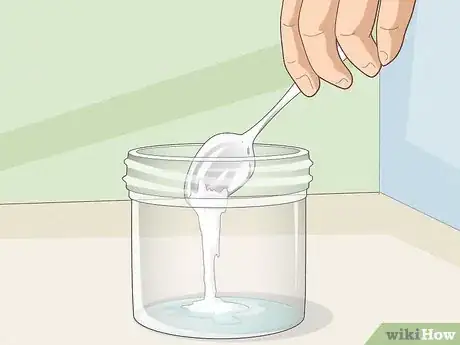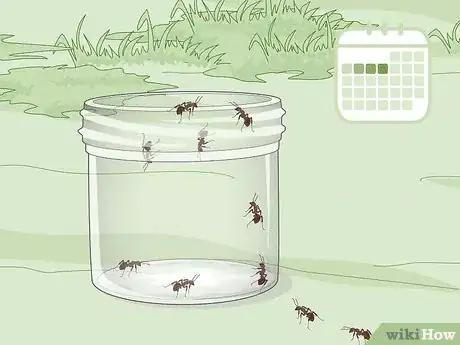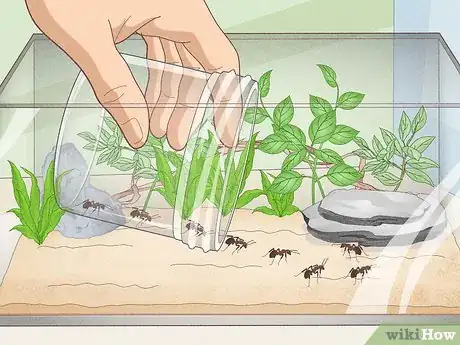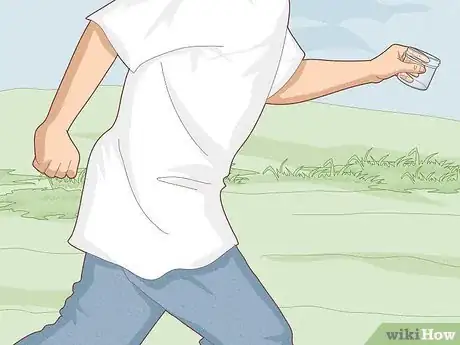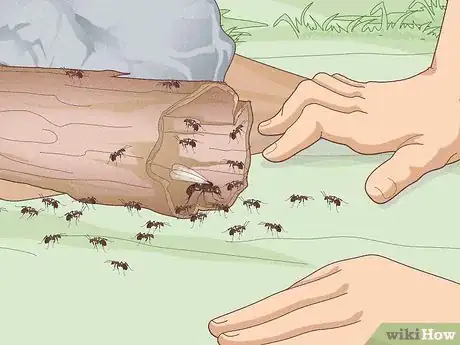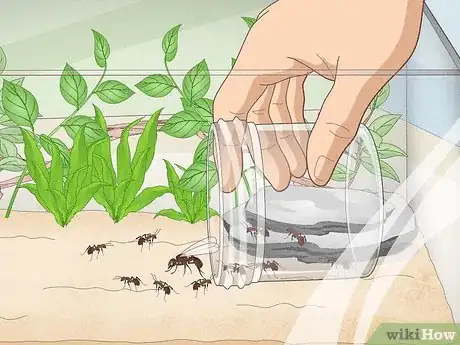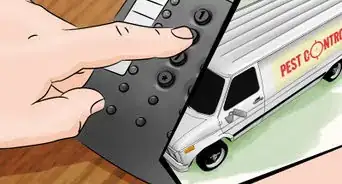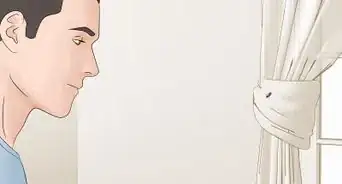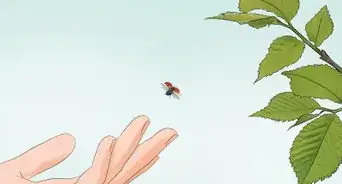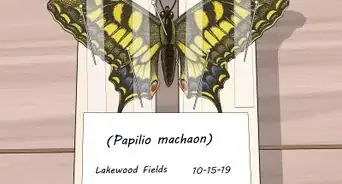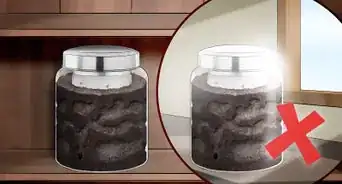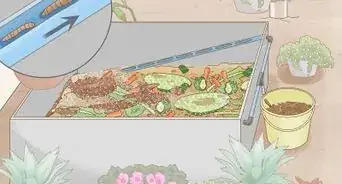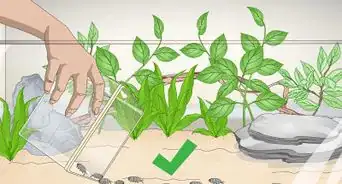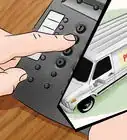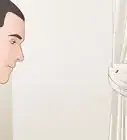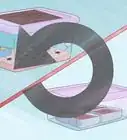This article was co-authored by Hussam Bin Break. Hussam Bin Break is a Certified Commercial Pesticide Applicator and Operations Manager. He and his brother Hussam co-founded Diagno Pest Control in the greater Philadelphia area in 2018, and have since expanded their services to include the New Jersey market. Diagno Pest Control has received Home Advisor's Top Rated and Elite Service Badges for quality of work and customer service.
This article has been viewed 144,954 times.
Ants are very fast insects and look hard to catch. However, there are many ways to catch ants, from setting traps with bait to active hunting. Be sure to research your area to know which ants can be collected before starting your search. Once you've decided which ants you'd like to search for, you can collect your materials and begin looking.
Steps
Collecting Ants Using Bait
-
1Set up your jar or container. Collecting ants using bait is a relatively simple process that does not require a lot of time or energy. The majority of your time will be spent gathering and preparing your materials before you set your bait. Ants are attracted to sources of food, which are generally a combination of sugar and water. You'll also need a container to place your bait into, which can be any size, from a cup or glass to a gallon bucket.[1]
- Bait can be as simple as sugar and water, but feel free to use other food like fruit, vegetables, or starch.
- A general rule for collecting ants is the larger your trap, the more ants you will end up attracting.
-
2Place your bait in your container. The next step is to place your bait, whether it's sugar and water or other food, into your container. Make sure your container is stable and will not fall over when left for hours at a time. Old yogurt containers or tupperware make for great ant traps. Fill your container with small amount of sugar and water, or simply place your food onto the bottom.[2]
- Try using a sturdy container, like an old jar, to avoid it being disturbed or knocked over.
- Choose a container that is not more than six inches high to ensure that your bait is easily accessible.
Advertisement -
3Leave the container for a few days. Once you have placed your bait in a container you are ready to leave it out for a few days. Try to find a secluded place outside to place your container so that it will be less likely to be disturbed by other animals. Leaving your bait for a few days will ensure that ants swarm to it. [3]
- Check on your container daily to collect ants periodically instead of dealing with a large amount of ants all at once.
- Placing your container outside will mean that your bait might also attract other ground dwelling animals. Check your container frequently to make sure your bait is still intact. If it has been eaten, simply place more bait in your container and check back every few hours.
-
4Transfer your ants to an enclosure. Once you have collected your ants in a trap, collect your container and begin the process of transferring the ants to an enclosure. A enclosure can range from a larger container with soil and food to a more complex terrarium purchased at a pet store. If you are collecting ants for you first time, try making your own enclosure as terrariums are generally intended for ant farms and can be expensive.[4]
- Make an enclosure for your ants by placing soil and a food source in a container, like a large tupperware. Be sure that the container is well ventilated with small holes made by a pin or needle. The holes made by a pin or needle will be small enough so that the ants will still have oxygen without being able to escape.
- Look for proper terrariums at your local pet store or on websites devoted to ant collecting.[5]
-
5Try making peanut butter or honey traps. Peanut butter and honey traps are simple traps that attract ants quickly. Simply coat a small paper surface, like a piece of cardboard, cardstock, or paper, with a thin layer of honey and place it indoors or outdoors for a few hours. The ants will be attracted to the sugar and will become “trapped” in the peanut butter's or honey's stickiness.[6]
- If you don't have a swarm of ants after a few hours, leave your trap out and continually check on it every couple hours.
Hunting for Ants
-
1Familiarize yourself with ant species in your area. Familiarizing yourself with a particular ant species will help narrow down the areas you will need to search. Whether you are a novice or expert ant collector, knowing which ant you want to collect will determine where the ant can be found, how you can identify the ant, and whether any precautions need to be taken to ensure your safety. Research ant species in your area using online resources, like Myrmecos.[7]
- There are many online ant collecting resources that can help you identify ants once you have located them, like the Mississippi Entomological Museum.[8]
- Be sure to choose ants that don't display aggressive behavior, bite, or sting in order to avoid injury.
-
2Bring a container to place your ants into. You will need a container with a lid (jar, yogurt tin, tupperware) to place your ants into once you have found them. Be sure to place some soil in the bottom the jar to keep the ants in while you continue hunting. Make sure your container is large enough to easily place ants into, which is generally around a 2 inch diameter. Remember that you might be carrying this container around for a while, so try and choose a container that is small enough to be comfortable.
- There are a wide range of tools you can use to collect ants, from more professional tools geared toward preserving ants for scientific purposes to ordinary garden tools. Research which types of tools you'll need by consulting various ant collecting blogs, like keepinginsects. [9]
-
3Allow at least a few hours to ant hunting. Ants are small and nests can sometimes be difficult to find. Give yourself a few hours of hunting time to ensure that you find a generous amount of ants. If you live in a densely populated urban area you may want to consider hunting for ants in a park or wooded area.
- You may have to do a lot of walking, so be sure to wear comfortable shoes and clothing.
-
4Look for ants near rotting boards, rocks, or logs. Rotting boards, rocks, and logs are common places for ants to nest. Look for fallen logs or large piles of boards around a park or wooded area and begin moving them around to search for ants. Keep your eyes out for ant trails leading to or from wood piles and follow them to their source.[10]
- Once you've found some ants you can begin placing them in the container you brought with you. This can be done by simply having the ant crawl on your finger and transferring them to the container.
-
5Look for a queen. You'll need to find and catch a queen if you want to start an ant colony. However, before you find a queen you'll need to be able to identify her. Queens can sometimes be difficult to find, but with enough patience and time you should be able to find one. The best time to look for a queen is when they still have their wings and are looking for a mate, as they tend to be deep in their nests after they have mated. Consult online insect collecting resources to determine when the mating season of your specific species is.[11]
- Once you've found a queen place her in your container with the other ants.
- You will need a queen if you want to start an ant colony. Most colonies will only survive 4-6 weeks without a queen.
-
6Transfer the ants you collected into a proper enclosure. Once you have collected your ants and have finished hunting you can transfer them to a proper enclosure. Most proper enclosures can be purchased at pet stores or online store dedicated to insect collecting. Be sure that your container is large enough for the amount of ants you have collected.
Community Q&A
-
QuestionHow do I find a queen ant?
 Community AnswerDuring the spring and summer, you will see large ants with big gasters, or butts -- this is how you know it's a queen. If you want it to start a colony, use a test tube or a small bottle.
Community AnswerDuring the spring and summer, you will see large ants with big gasters, or butts -- this is how you know it's a queen. If you want it to start a colony, use a test tube or a small bottle. -
QuestionAre all ants with large back ends queens?
 Community AnswerQueens often have bigger thoraxs (middle parts) and bigger gasters (back ends), so looking for those differences might help you identify a queen. However, major worker ants or fighting ants can be bigger than other workers as well.
Community AnswerQueens often have bigger thoraxs (middle parts) and bigger gasters (back ends), so looking for those differences might help you identify a queen. However, major worker ants or fighting ants can be bigger than other workers as well. -
QuestionWhat is the best way to make a home for ants?
 Community AnswerI would suggest reading through wikiHow's article on building an ant farm for some advice.
Community AnswerI would suggest reading through wikiHow's article on building an ant farm for some advice.
Warnings
- Some species of ant can deliver a painful sting. Ensure you are not dealing with one of these types before trying to catch them.⧼thumbs_response⧽
- Ants will bite if they feel the need to, so wear gloves at all times when catching ants.⧼thumbs_response⧽
Things You'll Need
- Jar or plastic container
- Food
- Sand or soil
- Garden shovel
- Gloves
References
- ↑ http://www.keepinginsects.com/cockroaches-locusts-ants/ants-as-pets/
- ↑ http://www.ant-farms.com/where-to-get-ants-to-put-in-an-ant-farm.html
- ↑ http://www.ant-farms.com/where-to-get-ants-to-put-in-an-ant-farm.html
- ↑ http://www.keepinginsects.com/cockroaches-locusts-ants/ants-as-pets/
- ↑ http://www.keepinginsects.com/cockroaches-locusts-ants/ants-as-pets/
- ↑ http://mississippientomologicalmuseum.org.msstate.edu/Researchtaxapages/Formicidaepages/Collecting.tips.htm#.WEhP9mQrLqZ
- ↑ http://www.myrmecos.net/north-american-ants/
- ↑ http://mississippientomologicalmuseum.org.msstate.edu/Researchtaxapages/Formicidaepages/Identification.Keys.htm#.WEhV-GQrLqY
- ↑ http://www.keepinginsects.com/cockroaches-locusts-ants/ants-as-pets/
About This Article
To catch ants with bait, cover a piece of cardstock or paper with peanut butter and leave it out for a few hours, which will attract and trap nearby ants. Alternatively, choose a container that's less than 6 inches tall, like a cup or glass, so the ants can get into it, and add sugar and water as bait. Once your bait is in place, put the container in a secluded area outdoors and leave it for a day or so for ants to climb into. For tips on how to make an ant enclosure or how to hunt ants, keep reading!

